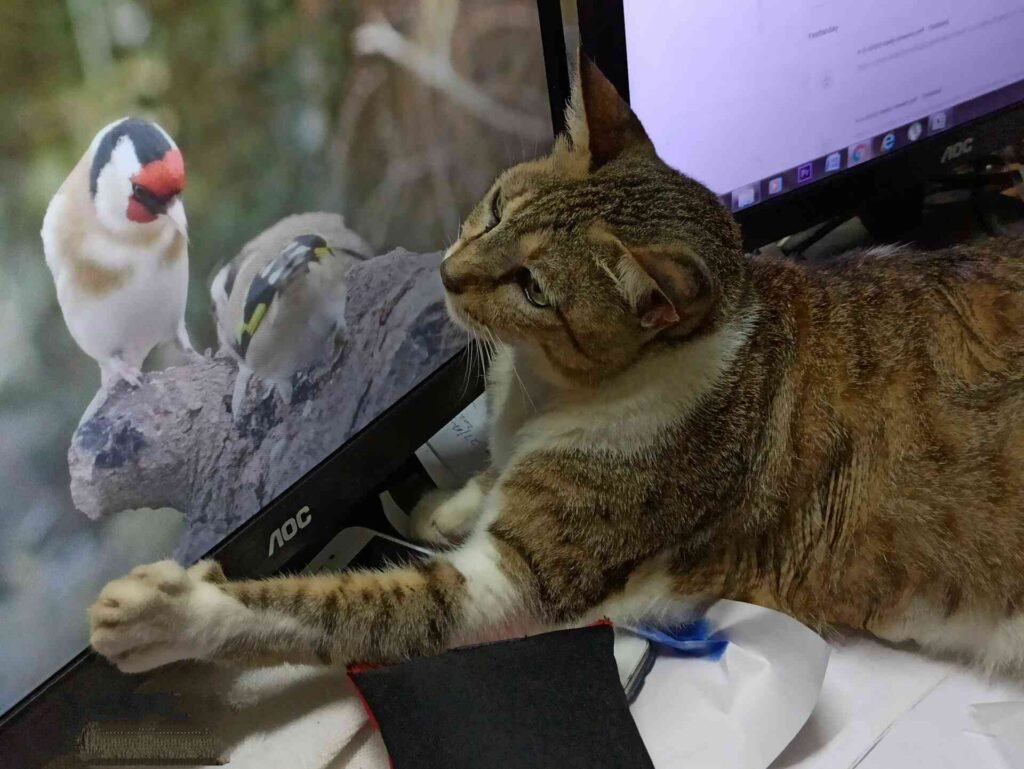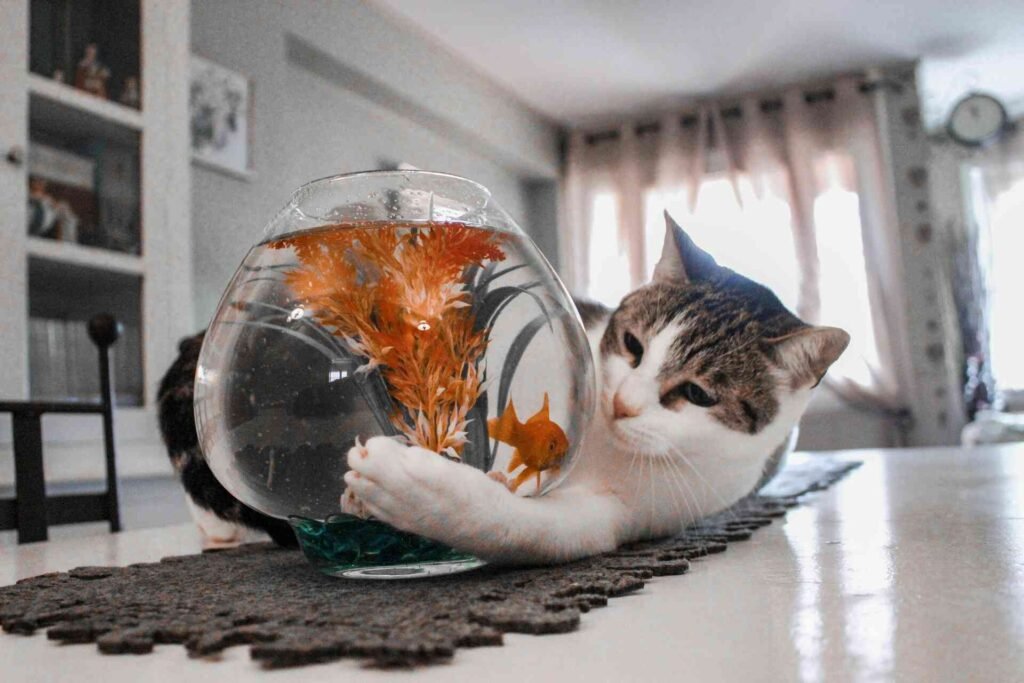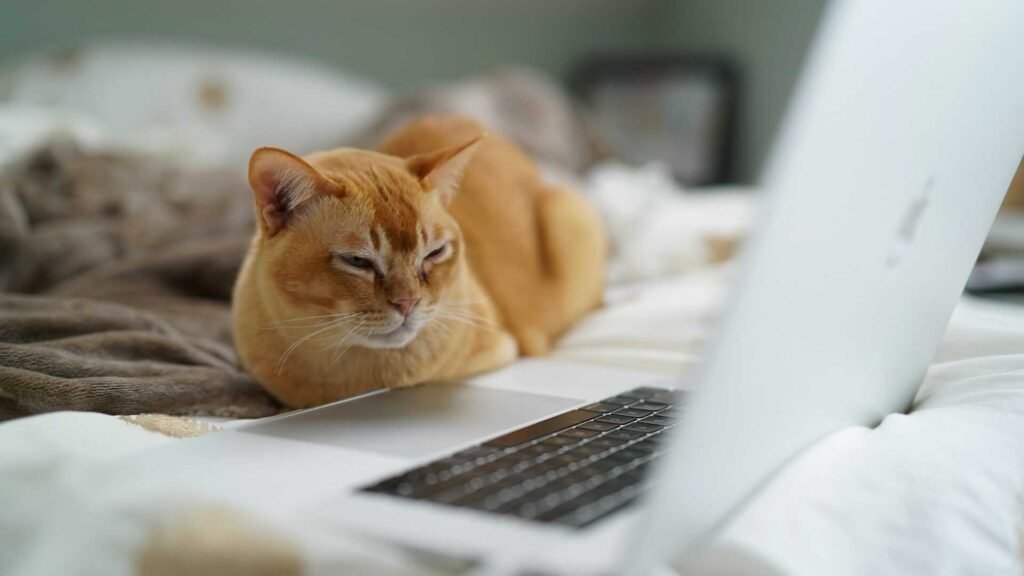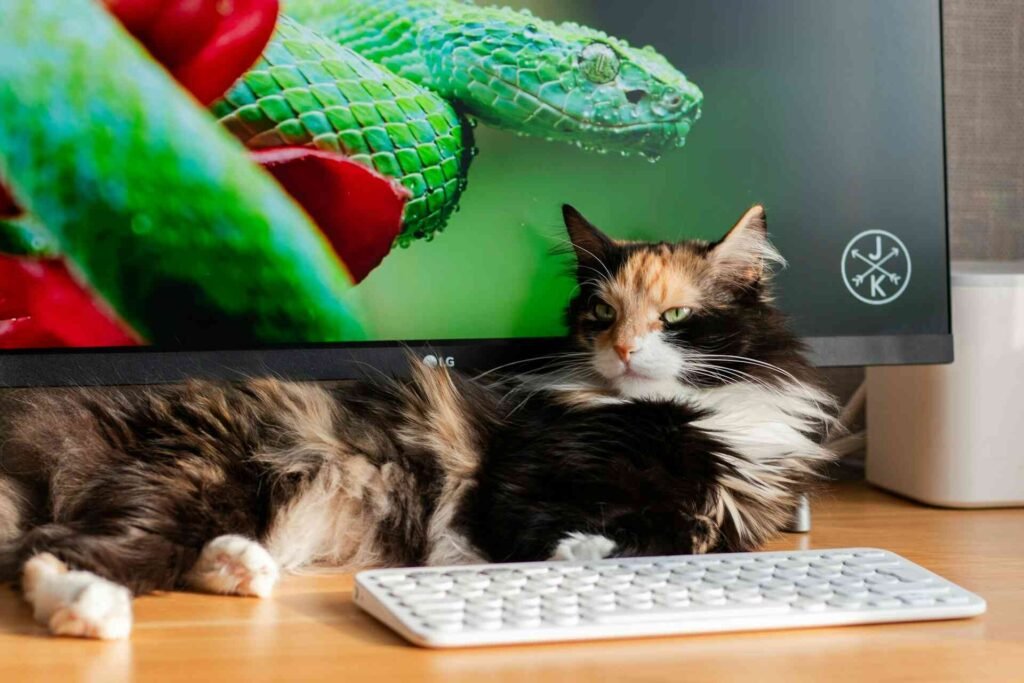If you’ve ever witnessed your cat batting at the screen during a nature documentary or staring intently at birds flitting across your television, you’re not alone. In our previous exploration of Why Do Cats Watch TV, we discovered that cats can indeed see what’s happening on modern screens. But this raises another fascinating question: what exactly do our feline friends prefer to watch when they’re enjoying screen time?
Today, we’re diving into the viewing preferences of cats, from the content that makes their whiskers twitch with excitement to the programs that leave them cold. Understanding what captures your cat’s attention can not only provide them with better entertainment but also offer fascinating insights into their natural instincts and behaviors.

Nature’s Greatest Hits: Why Birds Top the Feline Viewing Charts
When it comes to feline viewing preferences, birds consistently rank as the number one crowd-pleaser. This preference isn’t surprising when we consider a cat’s natural hunting instincts.
Birds combine several elements that cats find irresistible:
- Quick, erratic movements that trigger predatory responses
- Small size that matches their natural prey
- Distinctive chirping sounds that alert cats even when they’re not looking at the screen
- Flight patterns that mimic the unpredictable movements cats have evolved to track
Many cat owners report that bird documentaries or dedicated “videos for cats” featuring feathered creatures consistently hold their pets’ attention longer than any other content. The combination of visual stimulation and audio cues creates a multi-sensory experience that many cats find nearly impossible to ignore.
A trip to the window is often a highlight of a cat’s day, with outdoor birds providing premium entertainment. The same fascination extends to television birds, which might explain why so many cats become transfixed when bird documentaries appear on screen. This fascination often leads to behaviors like pawing at the screen or making chattering sounds – the same reaction many cats display when watching real birds through windows.
When a cat’s attention is fixed on avian programming, it’s engaging in what behaviorists call “hunting by proxy” – a safe outlet for their natural predatory instincts. This kind of engagement can be particularly beneficial for indoor cats who have limited access to natural hunting opportunities and may help prevent boredom-related behaviors.
Beyond Birds: The Complete Feline Viewing Hierarchy
While birds may reign supreme in feline entertainment preferences, they’re not the only content that captures cats’ attention. Understanding the full spectrum of what cats enjoy watching can help you curate the perfect feline viewing experience:
Small Mammals
After birds, small rodents like mice, squirrels, and rabbits tend to rank high on cats’ watchability scale. These creatures trigger similar hunting responses due to their size and movement patterns. Many cats show particular interest in close-up shots of mice scurrying across the screen – a testament to their evolutionary programming as skilled mouse hunters.
Fish and Underwater Scenes
Aquatic content presents an interesting case in feline viewing preferences. Many cats show remarkable interest in fish swimming across the screen, tracking their movements with the same intensity they might show while watching an actual aquarium. The fluid, continuous motion of swimming fish creates a mesmerizing effect that many cats find engaging.
While some cats may eventually lose interest after realizing they can’t actually catch the fish, others remain entertained by the continuous movement. Videos specifically designed for cats often feature extended underwater sequences precisely because they maintain feline attention effectively.

Insects and Small Moving Objects
Insects represent another category of moving objects that frequently capture feline interest. The quick, unpredictable movements of flying insects or crawling bugs on screen often elicit focused attention and tracking behaviors from cats.
Some specialized cat videos feature animated insects moving across solid-colored backgrounds – a simplified visual that eliminates distractions and creates high contrast, making it easier for cats to focus on the movement.
Other Cats and Animals
Interestingly, many cats display curiosity about other felines on screen, though their reactions vary dramatically based on individual personality and socialization. While some cats appear fascinated by their on-screen counterparts, others may show signs of agitation or territorial responses.
Larger animals typically generate less consistent interest, though some cats show curiosity about animals they’ve never encountered before. Wild cats and big cats sometimes attract domestic cats’ attention, possibly due to similarity in movements and behaviors despite the size difference.
Content Characteristics That Captivate Cats
Beyond specific animal subjects, certain visual and audio characteristics consistently make content more appealing to feline viewers:
Visual Elements That Engage Cats
| Visual Element | Why Cats Respond | Best Examples |
|---|---|---|
| High Contrast | Cats see contrast better than fine detail | Black birds against bright sky |
| Quick Movement | Triggers hunting instincts | Darting fish or flying insects |
| Appropriate Size | Matches natural prey dimensions | Small-to-medium sized creatures |
| Simple Backgrounds | Reduces visual distractions | Subjects against solid colors |
| Screen-Edge Movement | Mimics prey entering territory | Objects that enter and exit frame |
Audio Characteristics That Perk Up Feline Ears
Sound plays a crucial but often overlooked role in maintaining cat engagement with television. Specific audio frequencies and patterns can dramatically increase a cat’s interest in on-screen content:
- High-pitched sounds in the frequency range of prey animals (mice, birds)
- Rustling or scurrying noises that indicate movement
- Chirps and tweets that match visual bird content
- Absence of loud, startling sounds that might cause stress
The combination of appropriate visual and audio elements creates the most compelling viewing experience for cats. This explains why specially designed cat videos often feature birds or fish with enhanced natural sounds but minimal background music or narration.
What Cats Don’t Like to Watch: Content to Skip
Understanding what doesn’t interest cats is just as valuable as knowing what captivates them. Most cats show limited or no interest in:
- Dialogue-heavy programs with minimal movement
- Abstract visuals without recognizable movement patterns
- Slow-moving content without prey-like characteristics
- Very large animals that don’t trigger hunting responses
- Extremely fast action that moves too quickly to track

These insights can help explain why your cat might be transfixed during a nature documentary but completely ignores your favorite drama series. The content that engages human viewers often lacks the specific visual triggers that capture feline attention.
The exception to these rules might be when a cat has formed positive associations with certain programs. Some cat owners report that their pets seem to “watch” regular shows with them, though behaviorists suggest this is likely more about the comfortable routine and your presence than actual interest in the content itself.
Cat-Specific Media: Are “Videos for Cats” Worth It?
The rise of cat-specific videos on platforms like YouTube raises an interesting question: are these specially designed programs actually better at engaging cats than regular television?
The Growth of Cat Entertainment
In recent years, a cottage industry of cat-specific videos has emerged, featuring hours of birds, squirrels, mice, and fish footage specifically edited to maximize feline engagement. These videos typically feature:
- High-contrast subjects against simple backgrounds
- Natural sounds enhanced for clarity
- Appropriate pacing that matches feline attention spans
- Content selection based on known prey preferences
Many cat owners report that these specialized videos can indeed hold their pets’ attention longer than standard television programming. The focused nature of the content, with minimal distractions and optimal visual characteristics, seems to create a more consistently engaging experience for many cats.
For cats left alone during the day, these videos can provide valuable environmental enrichment. When used thoughtfully, they can help prevent boredom and associated behavioral issues in indoor cats who might otherwise have limited stimulation.
Creating the Optimal TV Viewing Environment for Your Cat
If you’re interested in providing screen entertainment for your feline friend, several factors can help maximize their enjoyment and engagement:
Screen Positioning
Cat-friendly screen placement makes a significant difference in their viewing experience:
- Low positioning or a dedicated screen at cat height allows for comfortable viewing
- Stable surfaces nearby give cats a place to sit while watching
- Some distance between cat and screen prevents eye strain
Many cat owners find that incorporating strategic cat furniture placement near viewing areas creates the ideal setting for feline entertainment sessions.
Session Length
Like humans, cats have limited attention spans when it comes to screen time. Most cats show peak engagement during:
- Short sessions of 10-15 minutes
- Multiple brief viewings throughout the day rather than marathon sessions
- Times aligned with natural high-activity periods (dawn and dusk)

Observing your cat’s natural rhythms can help you identify the optimal times for introducing video entertainment into their routine.
Complementary Enrichment
Television should never be the only form of stimulation available to your cat. The most enriching environment combines screen time with:
- Interactive play sessions with toys that encourage physical activity
- Puzzle feeders that engage problem-solving abilities
- Climbing opportunities that utilize vertical space
- Window access for real-world wildlife viewing
FAQ: Common Questions About Cats’ TV Viewing Preferences
How Long Should I Let My Cat Watch TV?
While there’s no strict limit on feline screen time, moderation is key. Most cats naturally self-regulate their viewing, walking away when they lose interest. However, it’s best to treat TV as just one component of a varied enrichment strategy rather than the primary source of stimulation. If your cat seems unusually fixated on the screen for extended periods, introducing breaks with interactive play helps maintain a healthy balance of activities.
Can TV Replace Interactive Playtime?
No, television cannot replace direct interaction with your cat. While TV can provide passive entertainment and mental stimulation, cats need physical exercise and social engagement that only interactive play can provide. The hunting sequences that unfold on screen may mentally engage your cat, but without the physical exertion and tactile reward of actually “catching” prey, TV remains an incomplete substitute for regular playtime with toys.
Why Does My Cat Ignore Bird Videos?
Individual preferences vary significantly among cats. If your cat shows no interest in content that typically engages other felines, consider these possibilities:
- The specific visual characteristics might not appeal to your cat’s personal preferences
- Your cat may have limited hunting experience or prey drive
- The viewing angle or distance might not be optimal
- Other environmental factors might be creating distractions
Experimenting with different content types, viewing positions, and times of day can help you discover what might capture your particular cat’s interest.
Is My Cat Actually Watching the TV or Just Reacting to Movement?
This question touches on feline cognition and perception. While cats aren’t processing narratives or understanding content the way humans do, they are genuinely perceiving and responding to the visual stimuli on screen. Their engagement goes beyond simple light detection to include recognition of shapes, tracking of movement patterns, and sometimes even identification of other animals. This represents a more complex engagement than merely responding to changing light, it’s a form of visual processing aligned with their evolutionary hunting adaptations.
Can Watching TV Frustrate My Cat?
Some cats do show signs of frustration when unable to interact with on-screen prey. Signs might include pawing at the screen, looking behind the TV, or becoming vocally agitated. If your cat shows these behaviors, it doesn’t necessarily mean you should discontinue TV time altogether, but it might indicate a need to balance screen viewing with interactive play that provides the satisfaction of “catching” something. Physical toys that your cat can successfully capture after viewing sessions may help alleviate any built-up predatory tension.
Are There TVs Made Specifically for Cats?
While there aren’t televisions manufactured exclusively for cats, there are digital products designed with feline viewers in mind. These include:
- Apps and videos specifically created to engage cats
- Digital fish tanks and virtual aquariums with interactive elements
- Motion-activated video displays that respond to your cat’s movements
These specialized options often feature optimal contrast, movement patterns, and sometimes interactive elements that cats can trigger with their paws.
Conclusion: Curating the Purr-fect Playlist for Your Feline Friend
Understanding what cats like to watch on TV provides fascinating insights into feline perception, behavior, and evolutionary history. Far from being random, cats’ viewing preferences reflect millions of years of evolution as predators, with strong attractions to content that mimics their natural prey.
While individual preferences vary widely, the patterns are clear: content featuring small, quick-moving animals with prey-like characteristics consistently engages most cats, with birds taking the top spot on the feline viewing charts. The combination of appropriate visual triggers and complementary audio creates the most compelling viewing experience.
As we continue to learn more about feline cognition and perception, the field of cat entertainment media continues to evolve. The growing availability of cat-specific content makes it easier than ever to provide this form of enrichment for indoor cats.
Remember that television should always be just one component of a rich, stimulating environment that addresses all aspects of your cat’s physical and mental needs. When properly integrated with other forms of enrichment, screen time can be a valuable addition to your cat’s daily routine, providing mental stimulation and a safe outlet for natural hunting behaviors.
Next time you catch your cat transfixed by moving images on your screen, you’ll have a deeper appreciation for what’s happening in their fascinating feline mind. Far from passive viewing, your cat is engaging in a complex interaction between evolutionary instinct and modern technology – a perfect example of how our feline companions continue to adapt to and find enjoyment in the human world they share.
Looking for more? Explore our Cat Toys section for more posts like this, visit the Blog for fun and insightful reads, or browse our full Cat Category for everything feline-related, from care to comfort.
Disclaimer: This article is for informational purposes only and does not substitute for professional veterinary advice. Always consult your veterinarian for diagnosis and treatment tailored to your cat’s individual needs. Please verify current product information directly on the retailer’s site before purchasing.
References
- Long, Jeremy & Estey, Anthony & Bartle, David & Olsen, Sven & Gooch, Amy. (2010). Catalyst: Seeing Through the Eyes of a Cat. FDG 2010 – Proceedings of the 5th International Conference on the Foundations of Digital Games. http://dx.doi.org/10.1145/1822348.1822364
- Loop MS, Bruce LL. Cat color vision: the effect of stimulus size. Science. 1978 Mar 17;199(4334):1221-2. https://doi.org/10.1016/0042-6989(79)90135-4
- Shyan-Norwalt, M. R. (2005). Caregiver Perceptions of What Indoor Cats Do “For Fun.” Journal of Applied Animal Welfare Science, 8(3), 199–209. https://doi.org/10.1207/s15327604jaws0803_4
- Strickler, Beth & Shull, Elizabeth. (2014). An Owner Survey of Toys, Activities and Behavior Problems in Indoor Cats. Journal of Veterinary Behavior: Clinical Applications and Research. https://doi.org/10.1016/j.jveb.2014.06.005
Check out our most recent articles!
- Cats and Snow: Why Some Love It and Others Don’tSnow isn’t just uncomfortable for many cats, it’s a complete sensory overload. From cold paw pads to wet fur and changed landscapes, winter challenges feline comfort in unexpected ways. Learn how to recognize stress signals and create cozy alternatives for snow-averse cats.
- Christmas Names for Cats: From Classic to Creative Holiday IdeasNaming your holiday cat goes beyond festive fun. Discover why Christmas-inspired names age beautifully, spark instant connections with fellow pet lovers, and capture the warmth cats bring to our homes during the most magical season of the year.
- How to Keep Your Cat From Drinking Christmas Tree WaterYour cat’s obsession with Christmas tree water isn’t just annoying, it’s genuinely dangerous. From harmful bacteria to toxic additives, that festive reservoir poses real health risks. Discover practical solutions that protect your pet without sacrificing holiday cheer.
- Best Cat Toys for Christmas: The Ultimate Guide to Holiday JoyNot all Christmas gifts end up under the tree, some get batted across the floor at 3 AM. Explore the wonderful world of holiday cat toys that match your feline’s personality, from plush companions for cuddlers to high-tech options for the eternally energetic.
- Are Fake Christmas Trees Safe for Cats? A Holiday Safety GuideThat beautiful Christmas tree might look festive to you, but to your cat, it’s an irresistible climbing gym with built-in toys. Find out whether artificial trees are truly safer for cats and discover the hidden dangers lurking in your holiday decorations.
- The Best Christmas Gifts for Cats That’ll Actually Get Used (Not Ignored)Not all Christmas gifts land on the nice list with our feline friends. Discover which presents actually spark joy in cats and which ones end up gathering dust under the couch by New Year’s Day.
- Do Cats Eat Less in Winter? How Cold Weather Affects Your Cat’s AppetiteWinter brings more than just cold weather, it can completely change your cat’s eating habits. From bored indoor cats to outdoor ferals fighting to survive, discover what’s really driving those appetite changes and how to respond appropriately.
- Are Humidifiers Good for Cats? A Complete Safety & Health GuideNot all humidifiers are cat-safe, and some common practices could be toxic. Learn why cool mist beats warm mist, why essential oils are dangerous for felines, and how proper humidity levels between 30-50% support your cat’s breathing and coat health.
- How to Protect Leather Furniture From Cats (Without Losing Your Mind)Leather furniture and cat claws seem like natural enemies, but they don’t have to be. Learn why your cat is drawn to that expensive couch in the first place, and how simple redirects can save your furniture while keeping your cat’s natural behaviors satisfied.
- The Best Material for Cat Bowls: Protect Your Cat from BacteriaStainless steel, ceramic, or plastic, which material keeps your cat healthiest? We break down the science behind cat bowl materials, revealing why some harbor bacteria and others last decades without compromising your feline’s wellbeing.










